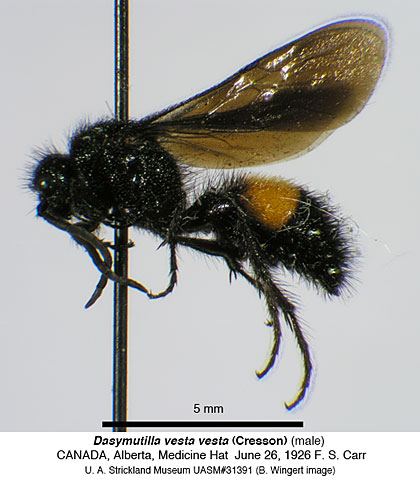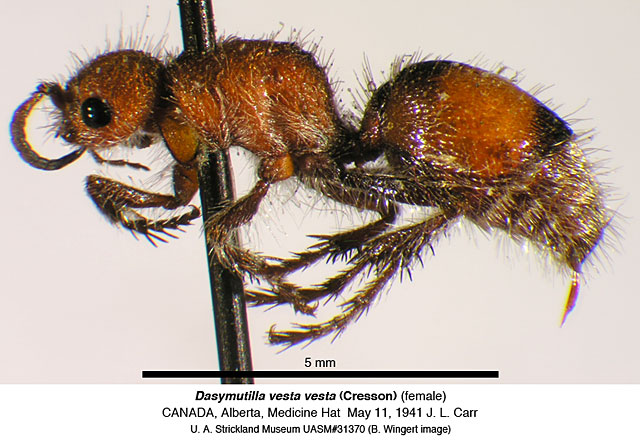Species Details
Dasymutilla vesta vesta
University of Alberta E.H. Strickland Entomological Museum Read more about this collection »
SeasonalityIn Alberta, specimens have been collected from April to September. Adults have been observed into October (Hennessy 2002).
IdentificationThese wasps are antlike in appearance (Manley and Pitts 2002). Compound eyes somewhat hemispherical. Felt line only present on tergite II. Females: 5.5-13.5 mm and wingless (Williamset. al., 2012). Setae not plumose (Manley and Pitts 2002). Head and mesosomal integument varies from pale orange to red (Williamset. al. 2012). Antennal scrobe, carinategena, and posterolateral head tubercles lacking (Manley and Pitts 2007). Elongate mesosoma with a narrow scutellar scale and no transverse carinae anterior to it (Manley and Pitts 2007; Williamset. al., 2012). Propodeum with small pits or fine grooves and only a few setae posteriorly. Males: 7.5-14.5 mm and winged (Williamset. al., 2012). Tergum and sternum II have reddish-brown setae (Manley and Pitts 2007). Black setae on Tergites 3 to 7 (Williams et. al.,2012). Mandibles lack notches ventrally (Manley and Pitts 2002) and sternum II lacks median pit (Manley and Pitts 2007). Wing venation normal with a sclerotized pterostigma (Manley and Pitts 2002). Coarsely pitted tegulae (Williamset. al., 2012). Mesonotum is broadened and elevated. Axilla prominent and notauli absent (Manley and Pitts 2002). Two spurs are present on the mesotibia. Pygidium has a fringe of setae at the apex (Manley and Pitts 2007).
Scientific Name
Dasymutilla vesta vesta
Habitat
Arid sandy regions.
Seasonality
In Alberta, specimens have been collected from April to September. Adults have been observed into October (Hennessy 2002).
Identification
These wasps are antlike in appearance (Manley and Pitts 2002). Compound eyes somewhat hemispherical. Felt line only present on tergite II. Females: 5.5-13.5 mm and wingless (Williamset. al., 2012). Setae not plumose…
These wasps are antlike in appearance (Manley and Pitts 2002). Compound eyes somewhat hemispherical. Felt line only present on tergite II. Females: 5.5-13.5 mm and wingless (Williamset. al., 2012). Setae not plumose (Manley and Pitts 2002). Head and mesosomal integument varies from pale orange to red (Williamset. al. 2012). Antennal scrobe, carinategena, and posterolateral head tubercles lacking (Manley and Pitts 2007). Elongate mesosoma with a narrow scutellar scale and no transverse carinae anterior to it (Manley and Pitts 2007; Williamset. al., 2012). Propodeum with small pits or fine grooves and only a few setae posteriorly. Males: 7.5-14.5 mm and winged (Williamset. al., 2012). Tergum and sternum II have reddish-brown setae (Manley and Pitts 2007). Black setae on Tergites 3 to 7 (Williams et. al.,2012). Mandibles lack notches ventrally (Manley and Pitts 2002) and sternum II lacks median pit (Manley and Pitts 2007). Wing venation normal with a sclerotized pterostigma (Manley and Pitts 2002). Coarsely pitted tegulae (Williamset. al., 2012). Mesonotum is broadened and elevated. Axilla prominent and notauli absent (Manley and Pitts 2002). Two spurs are present on the mesotibia. Pygidium has a fringe of setae at the apex (Manley and Pitts 2007).
Life History
Solitary ectoparasites of ground-dwelling wasps and bees (Mickel 1928). Adult females enter nests and deposit eggs into diapausing larvae or pupae (Arneson and Pitts 2003). The parasitic larvae then consume the entire…
Solitary ectoparasites of ground-dwelling wasps and bees (Mickel 1928). Adult females enter nests and deposit eggs into diapausing larvae or pupae (Arneson and Pitts 2003). The parasitic larvae then consume the entire host before entering the prepupal stage (Mickel 1928). The size of adults is believed to depend directly on the size of the host larva. Thus, host availability may be the cause of geographic size differences (Deyrup and Manley 1986). Also, females may determine whether to release or withhold sperm upon oviposition depending on host size. As they search for hosts, adult females build new retreats daily (VanderSal 2008). Females have up to four emergence periods per year, each lasting between five and ten days (Hennessy 2002). Male abundance follows closely. Activity of female generations may overlap, attributed to a secondary host search. Males may also be found between emergences. Mandible abrasion has been used to estimate emergence date in females. Consistent wear throughout generations implies a digging behaviour performed by all females. Adults are inactive midday when temperatures are highest; however, females have a higher tolerance to high temperatures than males (Mickel 1928). This is likely due to their reduced mobility. Many females overwinter and may have a lifespan of over ten months (Hennessy 2002). Males have shorter lifespans. Adult females arereputed to have a very painful sting (Mickel 1928).
Conservation
Not currently of any concern.
Diet Info
Currently known larval hosts: Bembix cinerea Handlirsch, Trypoxylon politum (Say) (=albitarse Fabricius), Nomia melanderi melanderi Cockerell (Williams, et. al., 2012), and Trypargilum politum (Say) (Manley and Pitts…
Currently known larval hosts: Bembix cinerea Handlirsch, Trypoxylon politum (Say) (=albitarse Fabricius), Nomia melanderi melanderi Cockerell (Williams, et. al., 2012), and Trypargilum politum (Say) (Manley and Pitts 2007). It is speculated that adult females eat nectar and larvae from host nests (Brothers 1989).
Range
In Canada, found in southern Alberta and BC. In the US, nearly transcontinental, but not reaching the West coast. Recorded from Tamaulipas in Mexico (Williams, et. al., 2012).
Notes
Information is somewhat limited on Dasymutilla species. Sex association is challenging due to sexual dimorphism and differences in geographic ranges between conspecific males and females. The wide geographical range…
Information is somewhat limited on Dasymutilla species. Sex association is challenging due to sexual dimorphism and differences in geographic ranges between conspecific males and females. The wide geographical range and variation within Dasymutilla vesta vesta has resulted in many synonymies (Manley and Pitts 2007). The brief nature of mating in this group reinforces this challenge by making it difficult to find copulating pairs (Williamset. al., 2011). Another challenge is the study of larval hosts which requires digging up host nests for identification (Hennessy 2002). Considering the variability in size of this species as well as its geographic range, it is very likely that many larval host species remain undiscovered (Williams, et. al., 2012). According to Mickel (1928), the type specimen for Dasymutilla vesta vesta is a female from Colorado territory and is located in the collection of the American Entomological Society of Philadelphia.
References
Author
Manley, D. G. and Pitts, J. P.
Title
A key to genera and subgenera of Mutillidae (Hymenoptera) in America North of Mexico with description of a new genus.
Publication Date
2002
Series Title
Journal of Hymenoptera Research
Volume
11
Pages
72-100
Author
Brothers, D. J.
Title
Alternative life-history styles of animals.
Publication Date
1989
Pages
279-291
Author
Mickel, C. E.
Title
Biological and taxonomic investigations on the Mutillid wasps.
Publication Date
1928
Series Title
United States National Museum Bulletin
Volume
143
Pages
1-351
Author
Arneson, L. and Pitts, J. P.
Title
Host records for Dasymutilla aureola (Cresson) and D. vestita (Lepeletier) (Hymenoptera: Mutillidae) from Northeastern California.
Publication Date
2003
Series Title
The Pan-Pacific Entomologist
Volume
79
Pages
256-257
Author
Williams, K. A., Manley, D. G., Pilgrim, E. M., Von Dohlen, C, Pitts, J. P.
Title
Multifaceted assessment of species validity in the Dasymutilla bioculata species group (Hymenoptera: Mutillidae).
Publication Date
2011
Series Title
Systematic Entomology
Volume
36
Pages
180-191
DOI
10.1111/j.1365-3113.2010.00555.x
Author
Hennessey, R. D.
Title
Population-level characteristics of Dasymutilla nigripes, D. vesta, and Timulla vagans (Hymenoptera: Mutillidae).
Publication Date
2002
Series Title
Florida Entomologist
Volume
85
Pages
245-253
DOI
10.1653/0015-4040(2002)085[0245:PLCODN]2.0.CO;2
Author
Deyrup, M. A. & Manley, D. G.
Title
Sex-biased size variation in velvet ants (Hymenoptera: Mutillidae).
Publication Date
1986
Series Title
Florida Entomologist
Volume
69
Pages
327-335
Author
Williams, K. A., Manley D. G., Deyrup, M., Von Dohlen, C., Pitts, J.P.
Title
Systematic review of the Dasymutilla monticola species-group (Hymenoptera: Mutillidae): using phylogenetics to address species-group placement and sex associations.
Publication Date
2012
Series Title
Zootaxa
Pages
1-29
Author
Manley, D. G. and Pitts, J. P.
Title
Tropical and subtropical velvet ants of the genus Dasymutilla Ashmead (Hymenoptera: Mutillidae) with descriptions of 45 new species.
Publication Date
2007
Series Title
Zootaxa
Pages
1-128
Author
VanderSal, N. D.
Title
Velvet Ant Biology: From Genetics to Cognition (Hymenoptera: Mutillidae).
Publication Date
2008
Pages
87
Specimen Information
There are 24 specimens of this Species.
UASM31371 - Dasymutilla vesta vesta
University of Alberta E.H. Strickland Entomological Museum
Place CollectedCanada: Alberta, Lethbridge
Collected BySalt, R. W.
Date Collected1941-07-28
UASM31374 - Dasymutilla vesta vesta
University of Alberta E.H. Strickland Entomological Museum
Place CollectedCanada: Alberta, Lethbridge
Collected BySalt, R. W.
Date Collected1941-07-28
UASM31379 - Dasymutilla vesta vesta
University of Alberta E.H. Strickland Entomological Museum
Place CollectedCanada: Alberta, Lethbridge
Collected BySalt, R. W.
Date Collected1938-05-15
UASM31380 - Dasymutilla vesta vesta
University of Alberta E.H. Strickland Entomological Museum
Place CollectedCanada: Alberta, Medicine Hat
Collected ByCarr, J. L.
Date Collected1939-08-18
UASM31389 - Dasymutilla vesta vesta
University of Alberta E.H. Strickland Entomological Museum
Place CollectedCanada: Alberta, Medicine Hat
Collected ByHocking, B.
Date Collected1949-08-11
UASM31390 - Dasymutilla vesta vesta
University of Alberta E.H. Strickland Entomological Museum
Place CollectedCanada: Alberta, Lethbridge
Collected ByGray, H. E.
Date Collected1923-07-24
UASM344202 - Dasymutilla vesta vesta
University of Alberta E.H. Strickland Entomological Museum
Place CollectedCanada: Alberta, Lost River
Date Collected1938-06-11
UASM31370 - Dasymutilla vesta vesta
University of Alberta E.H. Strickland Entomological Museum
Place CollectedCanada: Alberta, Medicine Hat
Collected ByCarr, J. L.
Date Collected1941-05-11
UASM31372 - Dasymutilla vesta vesta
University of Alberta E.H. Strickland Entomological Museum
Place CollectedCanada: Alberta, Medicine Hat
Collected ByStrickland, E. H.
Date Collected1939-08-08
UASM31373 - Dasymutilla vesta vesta
University of Alberta E.H. Strickland Entomological Museum
Place CollectedCanada: Alberta, Foremost
Collected ByStrickland, E. H.
Date Collected1925-05-22
UASM31375 - Dasymutilla vesta vesta
University of Alberta E.H. Strickland Entomological Museum
Place CollectedCanada: Alberta, Medicine Hat
Collected ByCarr, J. L.
Date Collected1941-05-07
UASM31376 - Dasymutilla vesta vesta
University of Alberta E.H. Strickland Entomological Museum
Place CollectedCanada: Alberta, Medicine Hat
Collected ByCarr, F. S.
Date Collected1925-04-10
UASM31377 - Dasymutilla vesta vesta
University of Alberta E.H. Strickland Entomological Museum
Place CollectedCanada: Alberta, Medicine Hat
Collected ByCarr, F. S.
Date Collected1925-04-10
UASM31378 - Dasymutilla vesta vesta
University of Alberta E.H. Strickland Entomological Museum
Place CollectedCanada: Alberta, Medicine Hat
Collected ByCarr, J. L.
Date Collected1940-07-05
UASM31381 - Dasymutilla vesta vesta
University of Alberta E.H. Strickland Entomological Museum
Place CollectedCanada: Alberta, Medicine Hat
Collected ByCarr, J. L.
Date Collected1940-07-02
UASM31382 - Dasymutilla vesta vesta
University of Alberta E.H. Strickland Entomological Museum
Place CollectedCanada: Alberta, Medicine Hat
Date Collected1930-09-24
UASM31383 - Dasymutilla vesta vesta
University of Alberta E.H. Strickland Entomological Museum
Place CollectedCanada: Alberta, Medicine Hat
Collected ByStrickland, E. H.
Date Collected1939-08-08
UASM31384 - Dasymutilla vesta vesta
University of Alberta E.H. Strickland Entomological Museum
Place CollectedCanada: Alberta, Orion
Collected ByStrickland, E. H.
Date Collected1939-08-12
UASM31385 - Dasymutilla vesta vesta
University of Alberta E.H. Strickland Entomological Museum
Place CollectedCanada: Alberta, Medicine Hat
Collected ByStrickland, E. H.
Date Collected1939-08-13
UASM31386 - Dasymutilla vesta vesta
University of Alberta E.H. Strickland Entomological Museum
Place CollectedCanada: Alberta, Medicine Hat
Collected ByCarr, F. S.
Date Collected1923-08-20
UASM31387 - Dasymutilla vesta vesta
University of Alberta E.H. Strickland Entomological Museum
Place CollectedCanada: Alberta, Edgerton
Collected ByStrickland, E. H.
Date Collected1939-08-31



